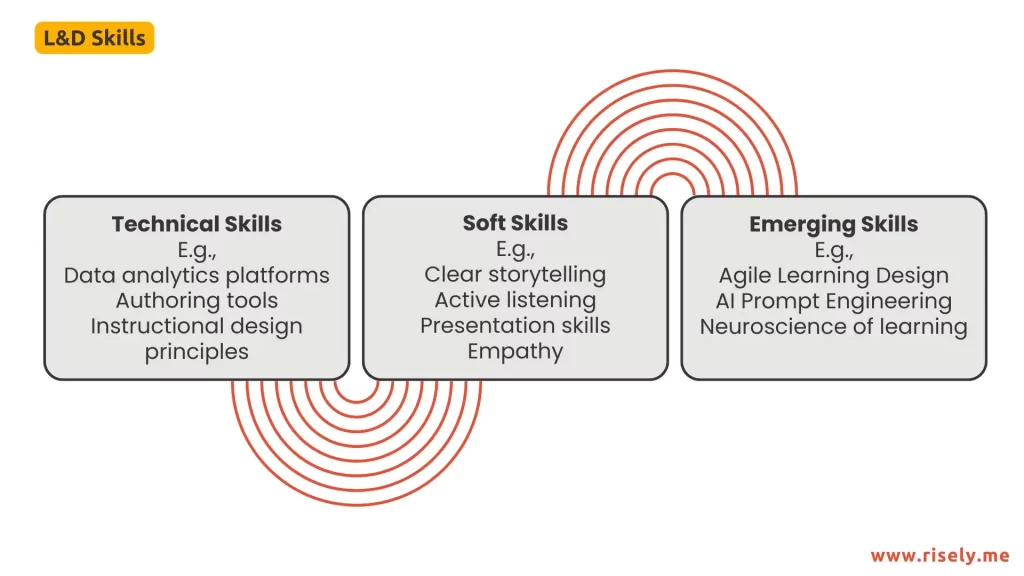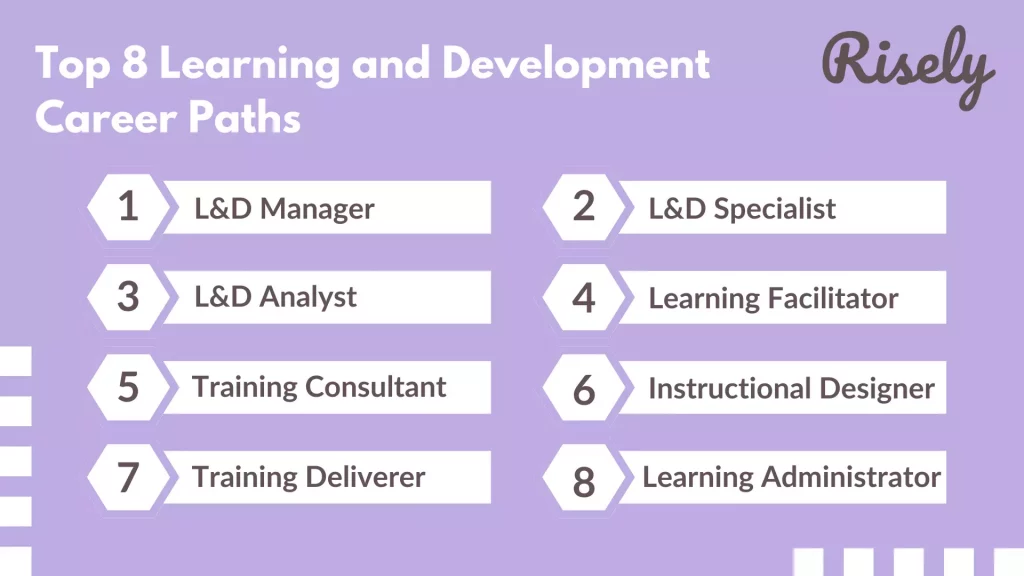Top 8 Learning And Development Career Paths in the Post AI World
Are you someone who believes in the power of continuous growth and learning? Do you enjoy helping others develop their skills and reach their full potential? If so, you’ve come to the right place! The world of professional growth is changing quickly. Learning and development has become very important for success in organizations. The old days of boring training sessions and one-size-fits-all methods are gone. Now, L&D experts use new ideas, advanced technology, and understand how adults learn best. They create fun and effective learning experiences that help employees grow and improve their leadership skills. This field offers many different and exciting job roles. So, if you think about a career in L&D, keep reading!Decoding Learning and Development Career Paths
Learning and development career paths cover many areas. This includes training programs, instructional design, and leadership development. In these roles, instructional designers focus on creating effective learning experiences. Development specialists work on building leadership skills. Jobs in L&D connect with human resources and data analytics.A quick analysis of our environment
The job of an L&D professional has changed a lot from being just a corporate trainer. You have new technologies like learning management systems (LMS), virtual reality, and fun learning platforms, which are changing how training is made and given. Now, L&D specialists must use these technologies to create learning experiences that are engaging and fit different learning styles. They are now key partners in the company, making sure learning plans meet business needs, encouraging new ideas, and supporting a culture of ongoing growth. As companies understand how important it is to have skilled and flexible workers, they need L&D professionals. These experts can help them adapt and succeed in this changing environment. But here’s the deal: We are also in unprecedented times. There are economic downturns that have led to significant changes in how organizations view L&D, the level of importance this function gets, and even layoffs. Future of Work Expert and Author, Edie Goldberg, recently joined us for a podcast where she shared something relevant for us: How long did the job description that you signed up for was really the parameters of your job? The key idea in figuring out L&D career paths today is that we need to constantly evolve as the environment changes. It helps us get fulfilment at work, and also keeps us fresh in terms of the skills and abilities we bring to the table. You can check out the full conversation below:What are the key skills in demand from L&D professionals?
Broadly, we can divide L&D competencies into hard and soft skills just like every other job role. But beyond the basics, there are a couple of skills that you should focus on:
- Analytical skills: As per LinkedIn, the number of L&D professionals listing “analytical skills” as one of their strong areas grew by a staggering 54% during the past year. This aligns well with the increased emphasis to tie in L&D initiatives with business objectives and grab a seat at the decision makers’ table. It also matches the increased need to adopt a data-driven approach toward work.
- Human skills: The second interesting area that every L&D professional should focus on emerges as “human skills.” 9 out of 10 L&D professionals surveyed by LinkedIn noted their importance. But what are human skills? This term refers to the set of skills like interpersonal communication, presentation, people management, and problem solving, which help you deal with the people around you effectively. It is quite important to consider because advanced tech like AI is gaining momentum and achieving more of the basic competencies that we hold.
Top 8 Learning and Development Career Paths

L&D Manager
- Role and Responsibilities: L&D Managers oversee an organization’s learning and development function. They design and implement training strategies, manage L&D teams, collaborate with stakeholders, and ensure alignment with business goals.
- Skills Required: Strong leadership, communication, and project management skills. Business understanding and the ability to analyze training needs and measure the impact of training initiatives are also crucial.
- How to Get There: Typically, L&D Managers have several years of experience in L&D roles and have successfully designed and delivered effective training programs. Obtaining a relevant degree and pursuing professional development opportunities can strengthen your candidacy for managerial positions.
L&D Specialist
- Role and Responsibilities: L&D Specialists focus on a specific area within learning and development, such as e-learning, leadership development, or compliance training. They design and develop training content and assess the effectiveness of learning programs.
- Skills Required: Expertise in their specialized area, instructional design skills, and proficiency in using authoring tools and learning management systems.
- How to Get There: Start as an entry-level L&D professional or instructional designer, gain experience in your chosen area of specialization, and continuously enhance your skills through workshops and certifications.
How do an L&D manager and L&D specialist differ?
An L&D Manager typically takes on a strategic and leadership role, overseeing the entire learning and development function within an organization. They set the overall L&D strategy aligned with business objectives and manage the L&D budget and team.
On the other hand, An L&D Specialist works more at the operational and implementation level. Their could be focused on any specific area, such as designing and developing specific training programs and materials, delivering training sessions and workshops, or conducting needs assessments for particular departments or roles.
L&D Analyst
- Role and Responsibilities: L&D Analysts use data and metrics to assess the impact and effectiveness of training initiatives. They gather insights, identify trends, and make data-driven recommendations for improving L&D strategies.
- Skills Required: Strong analytical and data interpretation skills, proficiency in data analysis tools, and an understanding of learning evaluation models.
- How to Get There: Begin as an L&D Coordinator or Training Administrator and focus on developing data analysis skills. Pursue courses in data analytics or business intelligence to enhance your qualifications.
Learning Facilitator
- Role and Responsibilities: Learning Facilitators deliver employee training sessions, workshops, and presentations. They engage learners, answer questions, and create an interactive learning environment.
- Skills Required: Excellent communication, presentation, and facilitation skills. A deep understanding of instructional techniques and adult learning principles is essential.
- How to Get There: Gain experience in training sessions as a Training Coordinator or Training Deliverer. Seek feedback and continuously improve your facilitation skills.
Training Consultant
- Role and Responsibilities: Training Consultants work externally or as part of an L&D firm. They advise organizations seeking to optimize training processes, develop learning strategies, and address specific training needs.
- Skills Required: Strong consulting, communication, and problem-solving skills. In-depth knowledge of L&D best practices and industry trends.
- How to Get There: Obtain significant experience in L&D roles, work with various clients on training projects, and build a strong reputation as a subject matter expert.
Instructional Designer
- Role and Responsibilities: Instructional Designers create effective and engaging training content. They collaborate with subject matter experts to design courses, develop learning materials, and incorporate multimedia elements.
- Skills Required: Proficiency in instructional design methodologies, creativity, and expertise in using authoring tools and multimedia software.
- How to Get There: Pursue a degree in instructional design or related fields. Build a strong portfolio showcasing your instructional design projects and continuously expand your knowledge of design principles.
Training Deliverer
- Role and Responsibilities: Training Deliverers conduct training sessions and workshops for employees. They ensure the effective transfer of knowledge and skill development among participants.
- Skills Required: Excellent presentation and communication skills, subject matter expertise, and the ability to engage learners.
- How to Get There: Start as a Learning Facilitator or Training Coordinator and gain experience delivering various training sessions. Seek feedback and continuously work on improving your training delivery techniques.
Learning Administrator
- Role and Responsibilities: Learning Administrators handle training programs’ logistics and administrative aspects. They manage training schedules, enrollments and handle training-related documentation.
- Skills Required: Strong organizational and administrative skills, attention to detail, and proficiency in learning management systems.
- How to Get There: Begin as a Training Coordinator or Administrative Assistant in an L&D department. Learn to use learning management systems and develop efficient organizational skills.
What You Will Need to Get Started in an L&D Career?
A strong start in adult learning, instructional design, and training delivery is very helpful. You don’t always need a specific degree in Learning and Development, but having a background in human resources, education, or communication can be useful as you start charting your L&D career path. Employers often want people with strong communication, interpersonal, and presentation skills. This is important because sharing information clearly and connecting with learners are key parts of the job. Knowing how to use technology used in L&D, like LMS and elearning authoring tools, can also help when you apply for entry-level jobs.#1 Finding your place in the L&D industry
Building a strong resume and portfolio is important too. Showcasing relevant experience, like volunteering for training projects or creating learning materials, can help you stand out.- Find Your Niche: Figure out which part of L&D you like best. Do you prefer instructional design, eLearning development, leadership development, or something else? Picking a specific area can help you focus your job search and growth in your career.
- Get Experience: Look for ways to gain practical skills in L&D, even if they are not full-time jobs. Volunteering to help with training programs, making learning materials for community groups, or leading workshops can give you useful hands-on experience.
- Consider Certifications: Think about getting important certifications to increase your credibility. Having certifications in instructional design, learning management systems, project management, or training methods can make you stand out as a candidate.
#2 Connecting with the whole wide world
Meeting other L&D workers, leaders, and experts can give you helpful insights and chances to grow. You can take advantage of networking by going to L&D events, joining webinars, and getting involved in online groups and forums about L&D. Building a strong network can help you find mentors, work with others, and stay updated on industry trends. Platforms like LinkedIn are great for connecting with other L&D workers. You can share your ideas and join in on discussions. Stay connected and participate actively. A strong network can really help your career grow. Primarily, you can explore:- 7 Top Learning And Development Newsletters
- Top 7 Learning And Development Podcasts You Must See
- 8 Learning and Development Conferences You Need to Attend
#3 Keeping up with changes
As technology changes how businesses operate, learning and development is seeing a wave of innovation. This is giving rise to new and interesting roles that change how companies think about learning and development. New technologies like artificial intelligence (AI), virtual reality (VR), augmented reality (AR), and data analytics are changing how learning and development is done. This has led to new job roles such as AI-Powered Learning Developers, VR/AR Experience Creators, and Learning Analytics Specialists. The question for you is how are you going to handle this? While there are plenty of concerns around the changed roles, it’s important to remember that continuous learning is vital to progressing professionally. That’s the mantra to moving forward and building a learning and development career path that’s uniquely yours. In a recent conversation with Kelli Dragovich over the Risely podcast, we popped this question, “What do you see 2025 like for the HR community?” Her answer centered around cautious optimism. She advised developing a point of view (a vision) and focusing on what you can do to get there. Catch more insights from an industry veteran with decades of experience here:Conclusion
Embarking on a learning and development career paths can lead to a fulfilling and impactful journey. As you navigate various roles and responsibilities, remember the importance of continuous learning, adaptability, and strong communication. Embrace collaboration and seek opportunities to demonstrate the positive impact of your training initiatives. You can position yourself for future growth by developing leadership and management skills. Your dedication to fostering a culture of learning and growth within organizations will empower employees and contribute to the long-term success of businesses. Stay passionate, committed, and open to growth, and you will thrive in the ever-evolving learning and development landscape. You can also sign up for Risely to take assistance to test your skills and train yourself to fill the skill gaps.Supercharge your journey with free L&D resources by Risely!
Grab your free copy of Risely’s learning and development strategy framework to kickstart growth.
FAQs
Is learning and development a good career?
Learning and development is a rewarding career that offers opportunities to empower others, contribute to organizational success, and stay at the forefront of continuous growth and improvement.
What is the scope of L&D?
The scope of L&D is vast, encompassing employee training, skill development, leadership programs, talent management, and fostering a culture of continuous learning to drive organizational success and growth.
What is career in training and development?
A career in training and development involves designing, delivering, and managing learning initiatives within organizations to enhance employee skills, performance, and overall professional growth.
Other Related Blogs
How to Create a Course with AI: A Guide for L&D Professionals
How to Create a Course with AI: A Guide for L&D Professionals According to a McKinsey survey(1), only 11% of business leaders believe their leadership development initiatives yield meaningful results.…
How to build a Learning and Development Action Plan ft Katie Greenwood
How to build a Learning and Development Action Plan ft Katie Greenwood Does your company’s Learning and Development (L&D) strategy feel like more “guessing” than “winning”? You’re not the only…
Generative AI for Learning and Development: Getting Started
Generative AI for Learning and Development: Getting Started In 2024, organizations spent $401 billion globally on corporate training(1), yet 70% of employees report feeling unprepared for the future of work…
Future proofing a learning strategy for organizations with Inna Horvath
Future Proofing a Learning Strategy for Organizations with Inna Horvath With the advent of AI, everyone’s anticipating changes. L&D leaders in charge of building a learning strategy for organizations are…


